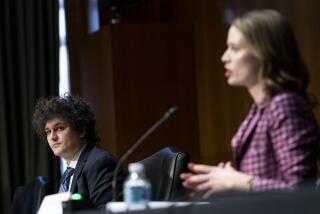Milken Fortune May Far Exceed Prior Estimates
NEW YORK â Investigators are piecing together evidence that the wealth amassed by former junk bond king Michael Milken from his association with Drexel Burnham Lambert is at least hundreds of millions of dollars greater than the staggering amounts already disclosed.
Federal prosecutors revealed over a year ago that Milken, 44, received direct compensation from Drexel of $1.1 billion from 1984 through 1987, including $550 million in one year. Those amounts alone made him the highest-paid employee in America.
But individuals analyzing hundreds of private partnerships set up at Drexel to benefit Milken, family members and Milkenâs favored employees estimate that Milken personally also received at least $1 billion from these partnerships. A portion of that would represent Milkenâs initial investment. But accountants and investigators say that most of the Drexel employee partnerships were extremely profitable, with partners in many cases receiving back hundreds or thousands of times their initial investments.
Detailed government records obtained by The Times for just 12 of nearly 200 partnerships in which Milken and family members are known to have held an interest show that Milken personally received at least $470 million from 1981 through 1988. His brother, Lowell, received at least $84 million. The 12 donât include some of the largest and most profitable partnerships Milken is known to have invested in.
A Milken spokesman characterized this analysis as false and containing âmisinformation.â
The existence of the private Drexel partnerships has been known for some time, mainly due to a continuing investigation by the House subcommittee on oversight and investigations. Earlier disclosures about the insider partnerships raised questions of improprieties, because Milken and other Drexel employees were allowed to get huge stakes in the profits of corporate buyouts Drexel was financing. The partnerships were given investment opportunities that were available to no one else and were not disclosed publicly. In some cases, the partnerships appeared to profit at the expense of Drexel customers and at times to the detriment of Drexel itself.
In the buyouts of Storer Communications and Beatrice Inc. in the mid-1980s, for example, the Milken partnerships secretly kept extremely valuable warrants instead of making them available to Drexelâs customers.
But, so far, little has been made public about the size of the partnerships and the amounts of money distributed from them.
Although it may be months before a full assessment is available of Milkenâs personal stake in the partnerships and his profits from them, one individual with direct access to partnership information said a $1-billion estimate of Milkenâs gross receipts from them is almost certainly conservative. âI think youâre extremely safe if you estimate a billion, as weird as that number sounds,â he said.
A source with knowledge of the partnerships estimates that the value of assets currently remaining in the partnerships is between $500 million and $600 million. This relatively small amount is said to reflect the sharp decline of the junk bond market and securities markets in general.
Milken, who headed Drexelâs Beverly Hills-based junk bond department, resigned from the firm in June, 1989, and pleaded guilty last April to six felony counts. Drexel, which also pleaded guilty to six counts, collapsed last February into bankruptcy proceedings.
Milken is due to be sentenced this month, perhaps as early as next week, although as of Friday a date still hadnât been set. Milken has already agreed to pay $600 million in penalties.
The convoluted records of the Drexel partnerships are being scrutinized intensively not only by the House subcommittee, chaired by Rep. John D. Dingell (D-Mich.), but by a horde of private lawyers, bankers and accountants. Creditors in the Drexel bankruptcy are attempting to trace the flow of money through the partnerships and are weighing whether they have legal grounds to try to recoup money from individual partners and the remaining partnerships themselves.
Ken Lerer, Milkenâs spokesman, refused to answer any specific questions about Milkenâs profits from the partnerships. He refused to give any estimate of how much Milken has received or the value of assets remaining in the partnerships. After a reporter showed him specific figures for 30 Drexel partnerships and a breakdown of Milkenâs ownership interest in 12 of them, Lerer said Friday in a telephone conversation:
âThe information you gave me is patently false and riddled with misinformation designed to hurt Michael Milken and his family on the eve of his sentencing. Itâs irresponsible of the Los Angeles Times to allow itself to be used in this fashion.â
Lerer, however, refused to elaborate on what Milken and his attorneys consider wrong about the figures. Bergman, Knox & Green, a Los Angeles accounting firm that kept records for most of the partnerships in which the Milkens had an interest, didnât respond to requests for comment.
The documents obtained by The Times include a study done by the General Accounting Office at the request of the House subcommitteeâs staff. It lists 30 partnerships, with the total estimated payouts to all partners for each partnership from 1981 through 1989. The total payout adds up to $2.043 billion. The actual payout, however, was probably about $2.003 billion, after eliminating double-counting that resulted from one partnership owning a big stake in another.
The GAO figures were an extrapolation based on information disclosed by Drexel employees who participated in an âIndemnification and Releaseâ program established by Drexel over a year ago. The program was established to protect employees from lawsuits by outsiders or from claims from the firm itself. As part of the release agreements, employees who chose to participate had to disclose to Drexel the full extent of their partnership interests. This information was later turned over to the government.
The GAO was able to estimate the total payouts to all partners for 30 partnerships based on data from employees who participated in the indemnification program.
Using other documents obtained from sources showing the exact percentage stake that Milken and his brother owned in certain partnerships, The Times was able to calculate how much Milken received from 12 of the 30 partnerships for which the GAO made estimates. These other documents show Milken owning a direct stake of between 3.6% and 99.9% in the 12 partnerships, plus, in many cases, large indirect stakes through other partnerships that were themselves partners in the original 12.
These figures showed that Milken received at least $470 million from the 12 partnerships. That amount, however, doesnât include the value of any assets remaining in the partnerships, nor anything paid out after 1988. It is known that many of the partnerships were wound down beginning in 1988.
The GAO, however, has no data on the many partnerships in which only Milken, his brother and a few loyal employees were the only partners. Milken and these other individuals refused to participate in the indemnification and release program and therefore werenât obliged to turn over information.
Because there are still big gaps in investigatorsâ information about Milkenâs stake in the partnerships, âwe donât know if weâre looking at half the iceberg, or just the tip of the iceberg,â a lawyer who has closely examined partnership records said.
Milkenâs stake in the largest partnership on the GAOâs list, Otter Creek Associates, amounted to $223.9 million, or 51.2% of the total $437.4 million paid out. But Milkenâs stake in the second and third largest on the list, SCI Capital Associates, which paid a total of $271 million, and BCP Capital Partners, which paid a total of $204.5 million, couldnât be determined.
SCI, however, is known to have stemmed from the Storer leveraged buyout, and BCP from the Beatrice buyout. Former employees of Drexelâs junk bond department said it was general knowledge that Milken held a large stake in each.
Evidence of the profitability of at least some of the partnerships came out in government exhibits presented during Milkenâs pre-sentencing hearings last month. The records show that employees who invested in partnerships holding warrants to buy Storer common stock after the buyout reaped a profit of over 5,000%.
Drexel has defended the existence of the partnerships, even though the firmâs top management in New York apparently didnât learn until after the federal investigation began that many of them existed. In a statement, Drexel spokesman Steven Anreder said: âThe firmâs view is that in regard to the partnerships, (top management) knew about and approved, they were viewed as part of the firmâs employee compensation and were the result of a calculated decision on the part of management to help motivate and keep good people.â
THE $2-BILLION PARTNERSHIPS
Estimated total amounts paid to all partners in the 30 Drexel employee partnerships, from 1981-88. Amounts do not include the value of any assets remaining in the partnerships or payouts made after 1988.
Est. distributions to all partners Partnership (in millions) Otter Creek Assoc. $437.4 SCI Capital Assoc. 271.0 BCP Capital Partners 204.5 Champlain Assoc. 95.8 Westham Capital Group 74.0 Intl. Consolidated Assoc. 69.4 BMA Limited Partnership 63.5 Raleigh Investment Management 62.7 Wilshire First Assoc. 60.1 Whitehall Financial Assoc. L.P. 52.0 Concordia Investment Assoc. 49.3 General Financial 47.9 Ocelot Assoc. 47.7 Fulton Partners 44.7 Framingham Partners 44.1 Montaigne Enterprises 35.9 Moredon Partners Ltd. 35.3 Belvedere Securities 34.7 Camont Assoc. 34.4 Dunmore Partners Ltd. 30.0 Kilgon Assoc. 29.4 Romont Assoc. 27.6 Rayburn Assoc. 26.1 First Financial Partners 25.4 Associated Capital 25.3 Centennial Financial 25.0 Cabat Assoc. 24.0 Lafayette Assoc. 24.0 Elstead Partners 21.8 Captran Venture Assoc. L.P. 20.7 TOTAL $2,043.7
Source: General Accounting Office study prepared for the House subcommittee on oversight and investigations
More to Read
Inside the business of entertainment
The Wide Shot brings you news, analysis and insights on everything from streaming wars to production â and what it all means for the future.
You may occasionally receive promotional content from the Los Angeles Times.










